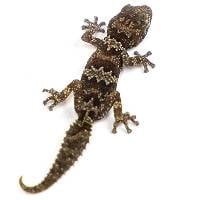Josh's Frogs
Ibity Ground Gecko - Paroedura bastardi ibityensis Care Sheet
NAME
Paroedura bastardi ibityensis, known also as Ibity ground gecko, are from the south and west side of Madagascar, mostly in arid and dry locations. They are semi-terrestrial and spend most of their time on the ground in areas of shrubs and thickets, but enjoy climbing as well.
COLORATION
Ibity ground geckos have a grey body color with a zig zag banding. They don’t show any remarkable colors, but have a range of brown colors which allows them to camouflage well among tree bark and leaf litter. Their back is covered with large spots or uncommon banding.

HOUSING
A 12x12x12 enclosure enclosure can easily house a single Ibity gecko, a pair, or even a trio. Males are territorial and should not be housed together, but multiple females can be housed with a male. Juveniles can only be raised successfully in a group if fed regularly; otherwise, there is risk of aggression and tail loss between individuals.
Substrates like Coco Select or other coco-fiber based substrates work well. A bioactive substrate can be made using BioBedding with springtails and isopods, offering your geckos additional food sources and reducing the need to spot clean. The substrate should be kept moist, but dry spots should also be maintained in the enclosure, especially when breeding this species.
Ibity ground geckos are nocturnal, and will spend time both on the ground and climbing. In the wild, they live in leaf litter as well as the lower trunks of trees. A layer of leaf litter over the substrate is recommended and they will make use of even small oak leaves as hides. Cork bark, especially pieces with numerous crevices, will provide additional hiding spots and provide some climbing material. Live plants are always a welcome addition to the Ibity gecko’s enclosure.
During the day, Ibity geckos should be kept at temperatures ranging from 75 to 79 F. with a warm spot of up to 90F. A heat source is not required as long as they are kept within that temperature range. If a heat source is provided, use a low wattage heat pad or bulb to prevent overheating. As a nocturnal species, UV lighting is not required for this species but isn’t harmful if provided. Temperatures should not fall below 70 F at night.
Humidity isn't a significant concern with this species. Keep relative humidity around 55-60%. This species should be lightly misted daily or every other day to provide water droplets on the enclosure walls, leaf litter, and other cage items from which the geckos can drink. The enclosure should have enough ventilation that it dries out after several hours. A shallow water dish can be provided but is not necessary with consistent misting. Live plants will help create humid microclimates within the enclosure.
Both temperature and humidity should be monitored with a digital thermometer/hygrometer.
SIZE
Adult Ibity ground geckos reach 3 - 4 inches from head to tail!
DIET
Ibity ground geckos are insectivores. Josh’s Frogs supplies all of the feeder insects your gecko will need! Hatchlings require ⅛-inch crickets, but within a few weeks will move up to ¼” crickets. We find that this species responds best to moving prey; a staple diet of medium crickets and dubia is good. Add mealworms, and other medium sized insect sources for variety. Dust the insects with a. vitamin/mineral supplement at every feeding.
SEX
Ibity ground geckos can be sexed relatively easily as males will exhibit conspicuous bulges at the base of their tail.
BREEDING
Males can be kept with females. The female will bury her eggs typically in more moist substrate once every three to four weeks or so. Drier spots in the substrate must be provided though, as females will not lay eggs in substrates that are too wet, which can cause a female to become egg bound. Eggs are very delicate, and great care should be taken if they are removed from the enclosure for incubation. Eggs collected should be placed in a bottle cap over dry sand or vermiculite. The bottle cap is then placed in a container half filled with moist medium. Incubate around 78-84 degrees. They will hatch around 60-80 days. Setup the babies like the adults. Brumation period is desired for breeding from late fall to late winter/early spring.

